02/07/13: Tweaked some of the text to better say what I mean.
01/09/13: Page Origin.
We needed a place to store primers, powder, and loaded ammo in the house, that would be child proof and separate from firearm storage.
As far as thieves go, we have a monitored security system so the police should respond within minutes of any break-in attempt, which limits the time available to thieves for breaking into places within the house.
I have attempted to make this closet as difficult as possible to access without a key.
I consider security like the story about the guys that went out walking in the woods one day and encountered a bear.
Every body started to run as hard as they could when one of the guys realized "I only need to outrun one other guy"
In other words, make your place just a little harder to break into than the guy next door, and hopefully, the thieves will go there, not your house.
Of course a lot of robbery victims are apparently chosen randomly, I sill like the bear story.
The bear story does apply to internet sites, since bad guys usually probe before trying to break in.
The CHL rules say you must protect your firearms from access by unauthorized persons.
I take that to mean, anyone who does not have my permission, anyone who isn't trained in firearm safety and care, and anyone who does not have a mature attitude toward firearm safety and proper use.
Personally, I don't want to add to the crime problem in the US today, so I keep my guns separate from ammo, both under lock and key (or combination).
Remember, protect your ammo, someone may have a firearm but no ammo, don't let him have yours.
Please see my page on gun safety.
Closets, in the house, are a good place to store gun powder since, if kept in it's original container, it will only burn quickly, not explode.
If you contain gun powder in a metal safe you are creating a bomb, think about it.
What if the house burns and the powder in the safe reaches kindling temperature?
BOOM!
What if the house burns and the powder in the safe reaches kindling temperature?
Primers are actually the explosive in a cartridge.
The explosive material in a primer deteriorates with heat, keep them cool and dry.
Loaded cartridges contain both primers and power, keep them cool and dry.
The Closet
I took our smallest closet, and replaced the knob with a good quality keyed knob lock.
Another reason, I chose this closet is, it has extra studs because of it's placement, making it more difficult to just kick a hole in the wall to gain access.
I replaced all the screws on the hinges with screws long enough to reach well into the studs that make up the door's frame.
I should probably get a steel 2-0 door for the closet, but then there would still be the sheetrock walls.
One of the problems with protecting you firearms and ammo is knowing when someone has had access to them, so breaking into this closet will cause lots of damage and noise.
I added a beefed up 1/8" thick steel striker plate in addition to the original, using screws long enough to get a good bite into the studs framing the door.
Since the hinges are on the outside, it would be easy to remove the hinge pins and simply pivot the door open at the lock side.
I replaced one hinge screw, top and bottom, with a hanger bolt that extends beyond the hinge surface into the hole on the opposite side of the hinge so the door can't be easily pivoted open if the hinge pins are removed (See PIC).
Next I rearranged the inside of the closet and added more shelves to provide more shelf storage for ammo and components.
I also considered putting a band of angle iron (or at least 1x4s) from corner to corner (lag screwed into all studs) to further complicate kicking a hole in the wall.
We also have a lock box inside the closet (not shown) for our handguns when we travel.
Note: I also had previously replaced the hinge and lock screws on all the house's outside doors.
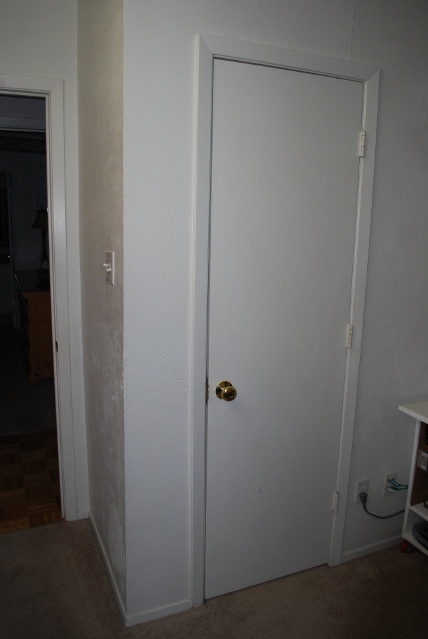
|
This is the smallest closet in the house, please note it has 3 hinges, on the outside (normal for a closet).
Originally, it had a transverse clothes bar (side to side) with two shelves above it.
|
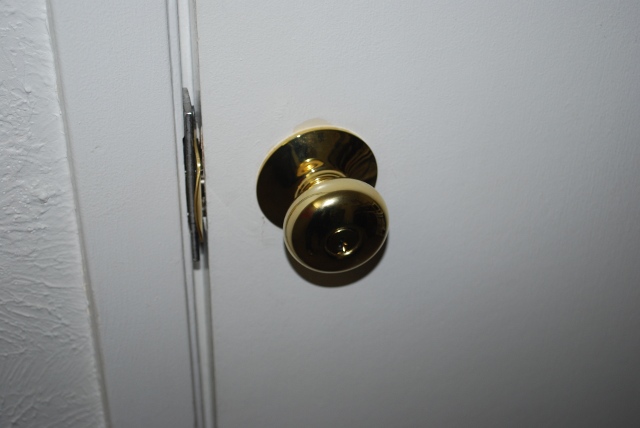
|
A Schlage lock, and you can see the new striker plate and how it limits how much you can pry the door from left to right.
Remember that striker plate is anchored into the studs.
If all you are concerned about is great grand children, you can stop right after replacing the lock, but if you might have a burglar, continue.
|
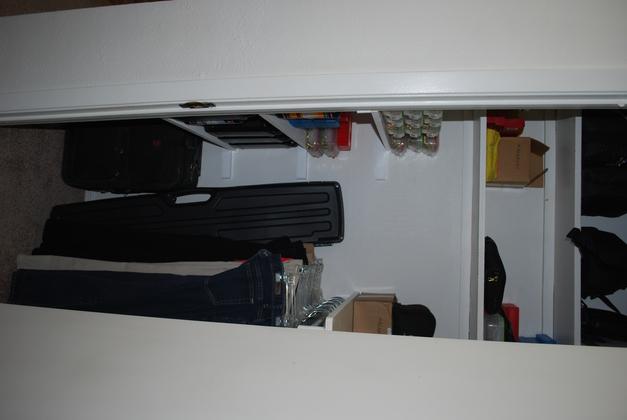
|
After the conversion, the two upper shelves remain, the clothes bar has been rotated 90° and lowered so Betty's pants can be hung without touching the floor, with a shelf above the clothes bar (on right) and three shelves added on the left with suitcase storage underneath.
|
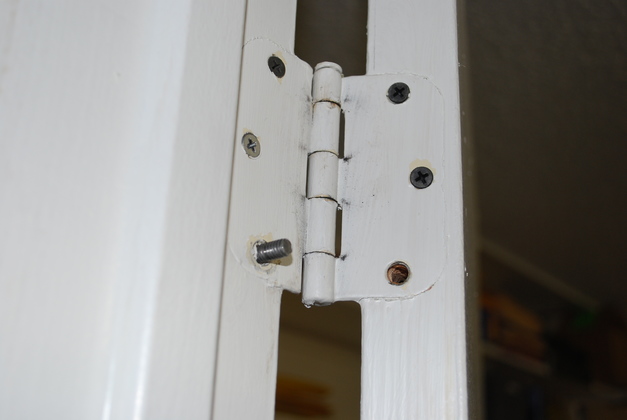
|
Here you can see the new, longer, hinge screws and the lower screw replaced with a 1/4" hanger bolt which protrudes into the opposite screwhole when the door is closed.
This makes it much harder to pry up the hinge pins and pivot the door open.
The new hinge screws are long enough to reach well into the studs framing the door.
Normally, door hardware screws are about 3/4" and only go into the soft white pine door facing, these screws are 3" long and into the studs framing the door.
The screws into the door are 2" long.
|
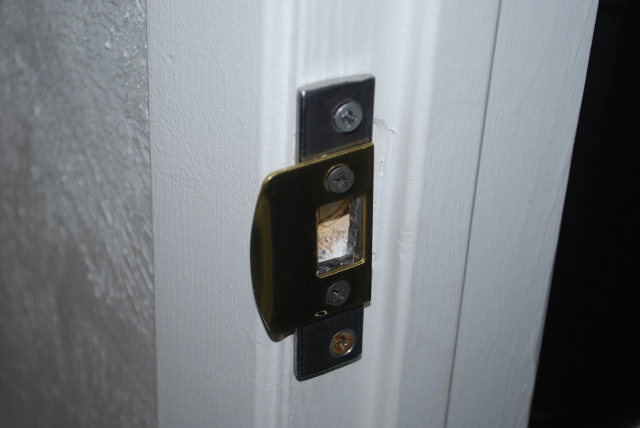
|
The striker plate was reinforced with a 1/8" X 1" steel plate and much longer screws that reach into the studs framing the door.
|
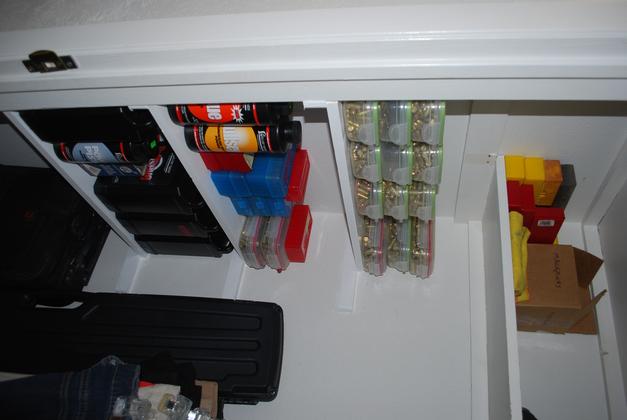
|
Left side showing new shelves holding loaded ammo and powder with suitcase storage underneath.
|
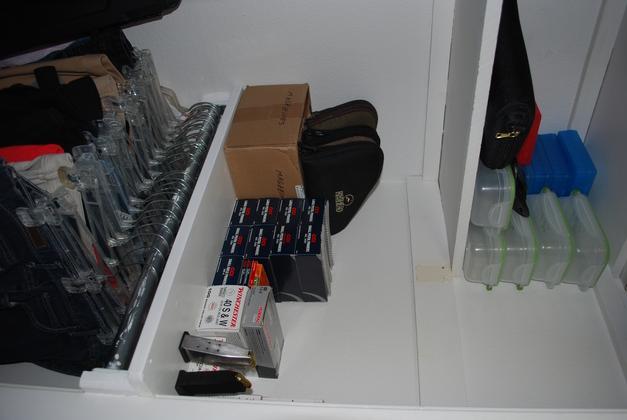
|
Right side showing lowered clothes bar, and shelf holding primers, magazines, extra gun rugs, etc.
I could probably add another shelf above this one.
The box of .40 S&Ws are left over from getting my CHL.
|











